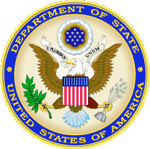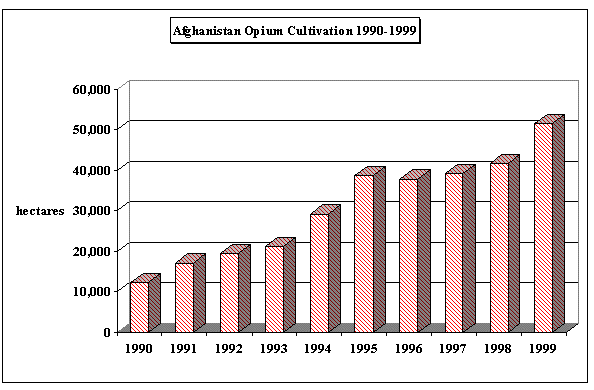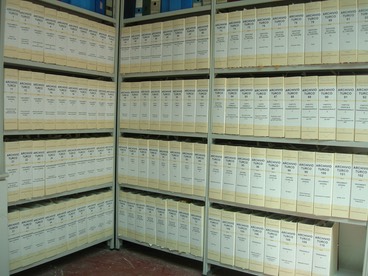www.state.gov/g/inl/rls/nrcrpt/1999/index.cfm?docid=923
AFGHANISTAN I. Summary According to USG estimates, Afghanistan became the world's largest producer of opium poppy in 1999. Traffickers of Afghan heroin route most of their production to Europe but also target North America. There is no single central government in Afghanistan where the Taliban and Northern Alliance factions (there are others) vie for national control. Despite UNDCP and NGO assistance, efforts at crop eradication, drug supply reduction, counter narcotics law enforcement, and demand reduction have completely failed. In fact, these factions, especially the Taliban, who control 97% of the territory where poppy is grown, promote poppy cultivation to finance their war machines. Those in positions of authority have made proclamations against poppy production but otherwise evinced no political will to fight narcotics. Rather, they are in active collusion with smugglers and criminal elements to manufacture and export heroin. Cultivators have lived through twenty-two years of civil war and generally view opium as their only means for survival in a hostile and uncertain environment. Institutional framework, or capacity, and resources to deal with problems at national, provincial and local levels as well as across different sectors simply do not exist in Afghanistan. The Taliban destroyed a handful of drug laboratories and eradicated 20 to 100 hectares of poppy fields, but otherwise took no significant action to discourage poppy cultivation, seize precursor chemicals or arrest and prosecute narcotics traffickers. Numerous reports indicated that all warring factions continued to profit from all facets of the drug trade at all levels. In spite of its own 1997 ban on the cultivation of opium poppy, the Taliban tax the opium poppy crop at about 10 percent, allow it to be sold in open bazaars, traded and transported, and receive payments from traffickers. Crop taxation imparts legitimacy to opium cultivation and distribution, and means that the Taliban benefit directly from the whole opium business. Afghanistan is party to the 1988 UN Drug Convention, but, as indicated, none of the political factions took meaningful steps to meet Afghanistan's obligations under the Convention. II. Status Of Country - In 1999, Afghanistan became the largest producer of opium poppy in the world, despite an on-going civil war and political instability. The Taliban and Northern Alliance continued to preoccupy themselves with the internal struggle for the control of Afghanistan. By year's end, the Taliban controlled 85 percent - 90 percent of the country's territory, including over 97 percent of the area where opium poppy is cultivated. The Northern Alliance generally controls the balance of the opium growing areas, mostly in the provinces of Badakhshan and Takhar. According to USG data, as a conservative estimate 1670 metric tons (MT) of opium were produced from approximately 51,500 hectares (ha) of poppy. In 1999 poppy cultivation on an additional 10,000 hectares (ha) led to a 23 percent increase in opium. New areas of poppy cultivation, high opium prices at planting and favorable weather during the growing season spurred the record crop. Heroin and morphine production at laboratories in Afghanistan requires large quantities of acetic anhydride, produced in Europe, Russia and Asia, China and India. Morphine and heroin pour across Afghanistan's difficult-to-police borders with Pakistan, Iran, and the Central Asian Republics of Tajikistan, Turkmenistan, and Uzbekistan. In addition to the corrupting influence on Afghan officials, drug production in and trafficking from Afghanistan has funded terrorist groups, increased regional heroin addiction in refugee and indigenous populations, undermined rule of law, led to frequent incidents of armed conflict between traffickers and law enforcement forces in neighboring countries, destabilizing the entire region. Afghanistan is not a center for money laundering; financial institutions barely exist. Private investment of drug trafficking profits reportedly accounted in some measure for a surge in building construction and other licit, commercial activity in Kandahar city during 1998. Afghanistan has not criminalized money laundering. III. Country Actions Against Drugs in 1999 Policy Initiatives. Afghanistan's lack of a national government precluded formulation and implementation of a countrywide, counter narcotics policy in 1999. In addition, the political will of Afghan military factions and the capacity of their "governmental" structures to effectively carry out drug control efforts are weak at best. Poppy cultivation increased and spread to new areas in 1999. The explosion in Afghan opium production is exacerbating regional tensions and doubling heroin flows to Europe. In the past, the Taliban admitted that consumption of "intoxicants," including opiates, is contrary to Islam and that, by extension, cultivation of opium poppy, the manufacture of morphine and heroin and trafficking in these drugs was in violation of Sharia (Islamic) law. Nonetheless, almost all poppy is cultivated in Taliban-held areas. The Taliban enjoys significant financial benefits from a reported ten percent tax on opium transactions. After the much-publicized release of the UNDCP's estimate that opium production had increased by seventy percent in one year, the Taliban made a political decision to unilaterally reduce poppy cultivation in Taliban-controlled territory. Mullah Omar, the supreme leader of the Taliban, issued a decree on September 30 to reduce poppy cultivation nation-wide by one-third in the 1999/2000 growing season. It remains to be seen if the Taliban will enforce this decree. Given current trends, even an unlikely 1/3 decrease in opium production would leave Afghanistan producing more opium than just two years ago. The governor of Nangarhar province (Taliban chief of the eastern zone of Afghanistan) and the governor of Kandahar (Taliban chief of the southwestern zone) issued two executive orders. The first imposed a total ban on poppy cultivation on government land and halved poppy cultivation in four districts. In addition, the governor of Kandahar issued a November 1 executive order implementing Mullah Omar's decree to reduce poppy cultivation in Kandahar, Zabol, Nimroz, Oruzgan and Farah provinces. The governors of Nimroz, Herat, Farah, Oruzgan, Zabol provinces followed suit with similar executive orders implementing Mullah Omar's decree in poppy growing areas. Again, there is no evidence these bans are anything but postures. Local authorities continued to maintain a 1998 ban on opium production imposed in the Xebec district of Badakhshan province. Badakhshan authorities subsequently extended it to the districts of Eshkashem and parts of Baharak in 1999. Accomplishments. None of the Afghan factions took any significant steps to achieve the goals and objectives of the 1988 UN Drug Convention. On the contrary, evidence indicates that the Taliban used alternative development in Afghanistan to boost opium production and fuel their war effort in 1999. The state high commission for drug control (SHCDC) is a partner with UNDCP in Taliban-controlled areas on drug control projects. While the U.S.continues to support UNDCP programs to monitor cultivation and production of opium poppy, UNDCP-managed small-scale development assistance projects have been swamped by the vast increase in opium cultivation. UNDCP's pilot alternative development/poppy reduction projects in Nangarhar and Kandahar provinces have also had mixed results in achieving poppy reduction targets. Security concerns also hampered USG on-site monitoring of the alternative development efforts of the USG-funded NGO, Mercy Corps International (MCI), in Helmand province. Local authorities did not meet commitments to significantly reduce poppy cultivation. The USG ended support in 1999 for the MCI project, because the Taliban failed to cooperate to reduce poppy planting in the project areas, in spite of extensive rehabilitation of the agricultural infrastructure. In fact poppy cultivation expanded significantly in the project areas. The USG strongly supports the UN Special Mission to Afghanistan and its efforts to break the apparent impasse in the peace process and to facilitate development of a broad-based government that respects international norms of behavior on narcotics, human rights, and terrorism. The Afghan Support Group (ASG) of major donors met twice during the year. At the meeting in Ottawa in December, the U.S.delegation strongly urged the ASG to include a cross-cutting narcotics theme as part of its action plan. The ASG agreed that the narcotics issues should be included as an important factor in all assistance planning for Afghanistan. The USG expressed its strong reservations about the efficacy of alternative development programs in Afghanistan, given current Taliban practices. Law Enforcement Efforts. In the absence of an effective central government and an operational drug policy in Afghanistan, enforcement of drug-related laws has been largely neglected. There are no effective national institutional arrangements for the planning and coordination of drug control efforts in Afghanistan. There were no independently verifiable instances in which narcotics or precursor chemicals were seized or destroyed as a result of law enforcement activities. According to the UNDCP, the Taliban destroyed 34 heroin narcotics laboratories in Nangarhar province in a series of well-publicized raids February 1999. The Taliban authorities claimed to have seized in the same raids 500 kilograms of opium, 70 kilograms of mixed heroin, 1200 liters of acetic anhydride, 500 liters of hydrochloric acid (HCl), 800 kilograms of ammonium chloride, 900 kilograms of charcoal, 1200 liters of sulfuric acid, 700 liters of ammonium hydroxide, and 380 liters of ethyl alcohol, but there was no independent verification. There are reports that laboratory owners subsequently relocated their operations to more concealed sites in the province. In March 1999, the Taliban head of the State High Commission for Drug Control (SHCDC) made a commitment to locate and dismantle similar heroin laboratories in Kandahar and Helmand provinces. Nonetheless, those laboratories continued to operate with impunity throughout the year. There were no independently verifiable reports of arrest or prosecution of drug traffickers or local drug dealers. The February Nangarhar raids netted 25 laboratory workers. The Taliban claim to have arrested traffickers and seized drugs coming through international airports under their control. In Kandahar, local authorities reportedly eradicated 400 hectares of poppy in May 1999; however, independent observers were unable to verify the full extent of the operation. The Secretary General of the Taliban's Anti-Narcotics Commission confirmed destruction of 200 hectares of opium poppy in Ghorak, 175 hectares in Khakhrez, and 25 hectares in Maiwand districts, where UNDCP-funded pilot crop substitution projects started in November 1997. Agreements and Treaties. Successive Afghan governments have signed a wide array of international conventions and made specific commitments with regards to the cultivation, trafficking and abuse of illicit drugs in Afghanistan, but independent evidence that any of their commitments were actually carried out is absent. Afghanistan is a party to the 1988 UN Drug Convention, the 1971 UN Convention on Psychotropic Substances, and the 1961 Single Convention. Cultivation and Production. Afghanistan is the world's largest producer of opium and a major producer of cannabis. By USG estimates, an estimated 1670 metric tons (MT) of opium gum (compared to 1350 MT in 1998) was produced from approximately 51,500 hectares (ha) of poppy in 1999. Poppy cultivation and opium production increased by 23 and 24 percent respectively, spurred by Taliban policy to tax cultivation (which unofficially legitimized it), high opium prices at planting, favorable weather conditions during the growing season, and the non-opposition of authorities in developing new areas for poppy cultivation. Opium poppy cultivation was found in 18 out of 29 provinces. Helmand and Nangarhar provinces accounted for three-fourths of the total opium poppy cultivation in Afghanistan according to the UNDCP. By USG estimates, Helmand province dominated cultivation with 25,500 ha, compared to Nangarhar province with 12,500 ha in 1999. Poppy cultivation is spreading in Afghanistan. In some provinces like Kunar, Lagman, and Takhar farmers have recently taken up opium poppy cultivation. The UNDCP poppy survey found cultivation in 27 districts in which opium cultivation had not been reported prior to 1999. The poppy growing season for most of Afghanistan begins in October/November and ends by May/June. For alternative development/poppy reduction projects to work, both local authorities and national level Taliban officials must be unambiguously committed to achieving reductions-something not yet in evidence. In addition, project implementers must make available sufficient resources by the beginning of the sowing season to induce farmers to substitute a licit crop. The SHCDC's work plan for achieving one-third reduction in poppy cultivation for the 1999 sowing season does not include a crop substitution component, but depends primarily on local authorities, public awareness of target sowing levels, and the threat of crop eradication for excessive cultivation to attain the planned goal. While local Shuras (Elders) are frequently of the opinion that reduction should match UNDCP assistance, future reductions, except those due to economic reasons and/or inclement growing conditions, will not occur without an unambiguous Taliban commitment, and are unlikely as long as hostilities, now financed largely by drug money, continue. Most laboratories refining opium into heroin operate in Nangarhar and Helmand provinces. There is evidence that heroin labs are being located close to the borders of some Central Asian countries. Drug Flow and Transit. Opium trading in Afghanistan and Southwest Asia is well-organized and well developed. Traders offer growers advances to finance inputs, and tide growers over while the crop is in the ground. They visit households to buy opium. This credit, or advance payment on future opium production is an integral part of livelihood strategies in poppy producing areas of Afghanistan. The relatively stable value of opium and its non-perishability mean that it also serves as an important source of savings and investment among traders and cultivators. The UNDCP estimates that about half the quantity of illicit drug produced in Afghanistan is consumed by Afghanistan and its neighbors Iran, Pakistan, Tajikistan, Uzbekistan, and Turkmenistan. The smuggling routes selected depend on the destination and on the commodity being smuggled. Historically heroin has been trafficked to Europe and, to a lesser extent, the United States through Iran and Pakistan, but increasingly now through the Central Asian Republics. Opium for the Pakistan market enters through Baluchistan and the Northwest Frontier Province. Raw opium remains primarily for local consumption in Pakistan and Iran. Trafficking organizations also have strong links to Gulf countries, and Dubai seems to be emerging as an important center for money laundering. Cannabis is usually transported from Afghanistan through Baluchistan to the Makran coast of Pakistan and from there by ship to the Gulf States and Europe. Cannabis is also increasingly transported through the Central Asian Republics by rail. UNDCP is the sole mandated UN organization in Afghanistan to make efforts to address drug trafficking. UNDCP has recommended organizing in Afghanistan competition against opium trading via a well-organized, and well funded, marketing program for legal, exportable crops. On a regional basis, UNDCP operates a number of programs to reduce Afghan drug trafficking in Southwest Asia, including specific law enforcement programs with Turkmenistan, Uzbekistan, Tajikistan, Pakistan, and Iran. Iranian and Pakistani law enforcement forces are more frequently engaging in armed confrontations with well-equipped narcotics traffickers moving large convoys across the Afghanistan border. Domestic Programs/Demand Reduction. Drug abuse is on the rise in Afghanistan. According to the UNDCP, heroin, opium and hashish are the most commonly abused drugs, along with a wide variety of easily available pharmaceutical drugs such as analgesics, hypno-sedatives and tranquilizers. Heroin, opium and other narcotics are used nearly exclusively by mouth or by inhalation, very rarely by injection. Of particular concern is opium abuse among women and passive opium exposure of very young children. Heroin addition is a rapidly growing problem especially in Jalabad, Kabul, Kandahar, Herat and expatriate Afghan communities in refugee camps. The Taliban Supreme Court in October 1997 issued a decision that "addicts of illicit drugs should be referred to a hospital/treatment center to receive proper treatment." Effective institutional arrangements for the planning and coordination of demand reduction programs, in particular, are not in place in Afghanistan. Kabul's only remaining mental hospital is reportedly the only place in Afghanistan providing limited treatment for drug addicts. A specialist drug treatment NGO for Afghan refugees operates in Peshawar, Pakistan. In Badakhshan province between 10 to 25 percent of the local population are believed to use opium. At least one NGO in Badakhshan has set up drug treatment facilities. The UNDCP distributed anti-drug materials among Afghan communities in Peshawar and Badakhshan. In June 1999, the Taliban launched an anti-narcotics campaign by dropping thousands of pamphlets on the capital of Kabul. Throughout the summer, the Kabul DCCU carried out a drug awareness campaign in city mosques and educational institutions. The Taliban have broadcast anti-drug radio programs during the year and local Kabul newspapers published anti-drug articles. In 1999, UNDCP redesigned its drug demand reduction sub-program to address the need for providing community based drug treatment and prevention programs. The programs are located in primary drug abuse areas in Afghanistan (Kabul, Jalabad, Herat, Maser and Kandahar) and around Afghan refugee camps (Peshawar and Quetta) in Pakistan where there is an identifiable drug abuse problem. Security problems and the changing geo-political situation in Afghanistan resulted in closing the UNDCP Badakhshan demand reduction program. IV. U.S.Policy Initiatives and Programs U.S.Policy Initiatives. The USG continues to urge the Afghan factions to demonstrate that they take international drug control obligations seriously. USG officials have repeatedly urged Taliban officials to respect and implement Afghanistan's international obligations on terrorism, narcotics, and human rights. Road Ahead. As long as war continues, prospects for meaningful progress on drug control efforts throughout Afghanistan remain dim. There is no indication that the Taliban intend to take serious action to reduce opium poppy cultivation, destroy heroin or morphine base laboratories or stop drug trafficking. To the extent that poppy continues to displace wheat production in Helmand and in the country as a whole, Afghanistan will face increasingly severe food shortages. The USG seeks to contain the flow of opium and heroin from Afghanistan through a stronger focus on regional counter narcotics cooperation. The USG will continue to impress upon the Afghan factions the importance that the USG attaches to unconditional counter narcotics measures by them. Unfulfilled commitments by the Taliban to reduce poppy cultivation have led the USG to halt funding for alternative development projects in Afghanistan. The Afghan Support Group (ASG) process continues to introduce anti-narcotics requirements in all appropriate development aid projects in Afghanistan. The USG supports UNDCP efforts in Afghanistan to institute such drug control conditionality in all assistance programs, but the significant rise in poppy cultivation in 1999 has drawn into question the future viability of alternative development/poppy reduction projects in Afghanistan. In the absence of action by the Taliban and the Northern Alliance to curb narcotics cultivation and trafficking, the USG will concentrate its efforts on law enforcement assistance to neighboring transit countries.

US. DEPARTMENT OF STATE
International Narcotics Control Strategy Report, 1999
Released by the Bureau for International Narcotics and Law Enforcement Affairs, U.S. Department of State - Washington, DC, 1 March 2000
Afghanistan Statistics (1991-1999) |
||||||||||
1999 |
1998 |
1997 |
1996 |
1995 |
1994 |
1993 |
1992 |
1991 |
||
Opium |
||||||||||
Potential Harvest (ha) |
51,500 |
41,720 |
39,150 |
37,950 |
38,740 |
29,180 |
21,080 |
19,470 |
17,190 |
|
Eradication (ha) |
- |
- |
- |
- |
- |
- |
- |
- |
- |
|
Cultivation (ha) |
51,500 |
41,720 |
39,150 |
37,950 |
38,740 |
29,180 |
21,080 |
19,470 |
19,470 |
|
Potential Yield (mt)1 |
1,670 |
1,350 |
1,265 |
1,230 |
1,250 |
950 |
685 |
640 |
570 |
|
1 DEA believes, based upon foreign reporting and human sources, that opium production in Afghanistan may have exceeded 900 metric tons in both 1992 and 1993. |
||||||||||



